|
Is feeding the fish in a marine reserve a bad practice? by Dr J Floor Anthoni www.seafriends.org.nz/indepth/fish_feeding.htm |
 |
 |
|
Is feeding the fish in a marine reserve a bad practice? by Dr J Floor Anthoni www.seafriends.org.nz/indepth/fish_feeding.htm |
 |
 |
|
|
|
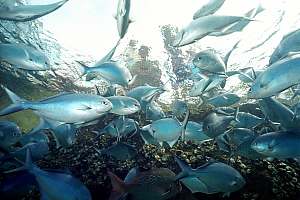 |
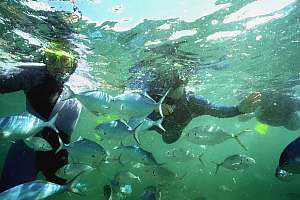 |
Not all fish species are corrupted (spoiled, bribed) by feeding. Some
don't like the food that people bring (red moki, butterfish, porae, most
plankton-feeders), others find the morsels just too small (large snapper),
or they are just too scared (leatherjacket, stingrays, marblefish). Most
could not be bothered, because they can find their food easily anyway (banded
wrasse, parore, butterfish). In a marine reserve for instance, one could
have 10,000 blue maomao, but only some 300-400 come to be fed. Of the thousand
or so of parore, only ten get attracted to the unusual food. Some fish
have lost their friends, and as they are lonely, find consolation with
schools of fish of other species. The odd kahawai, or large trevally may
stay for an easy meal. That is not a silly idea, because these schooling
fish, can find food only when they comb the sea side-by-side in dense formation.
A lone kahawai will find it very difficult to catch fish on its own. So,
in a way, by feeding the fish, the loners get a longer lease on life. In
return, they remain faithful to the reserve.
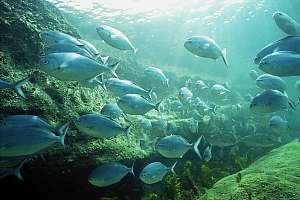 |
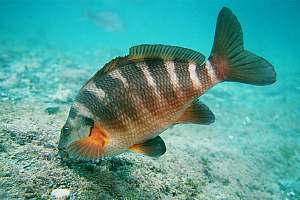 |
What people discovered, was that the fishes became tamer than they would
have been without feeding. The sea started to look like a real paradise,
and this again attracted more and more people to Goat Island. Many came
to let their small children experience the excitement of being in the water,
close to a lot of friendly fishes.
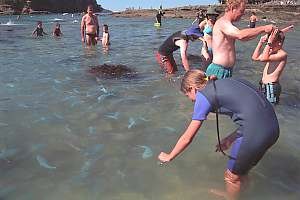 |
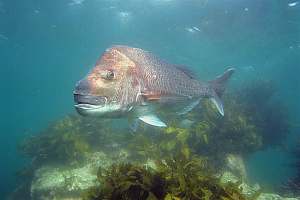 |
Attracted by the feeding, schools of fish concentrated near the main access point in the reserve. Because fish feel safe in numbers, it also attracted other fish that were not directly interested in food (large snapper, silver drummer). The sea began to look like an imagined paradise. It gave people an entirely new look on the sea, and it made people favour more marine reserves. The fishes that came for food, became the most effective ambassadors for marine conservation.
Not only did the fish benefit the visitors to the beach, but also local businesses where people hired their snorkel gear, bought food for the fishes and for themselves. The local community of Leigh who had to give up a number of very good fishing spots, finally received some benefits in return. The total increase in the economy was sufficient to feed another four families. Leigh has a permanent population of about 60 families, so the difference was noticeable.
People also came to the Seafriends Marine Conservation and Education
Centre where they visited the seawater aquariums with over 100 different
species in eight tanks, representing the main habitats around Leigh. They
also read books from the extensive library and pored over a thousand photos
showing the underwater environment. As long as people kept coming to the
reserve, they had a chance to educate themselves further about this newfound
charm, the sea. It also provided Seafriends with additional income to fight
for saving our seas, which are threatened in various ways.
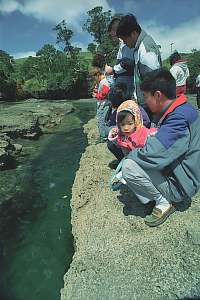 |
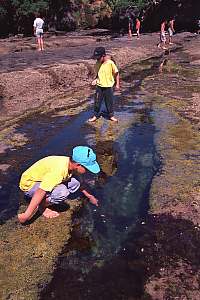 |
On a nice summer weekend, people were seen feeding the fishes such large quantities of food, that the sea water began to change. All this food somehow had to be broken down by bacteria in the sea, some of which resemble those inside human intestines. The water started to look murky, and currents were unable to cleanse the sand sufficiently to keep up with the supply of food. Some fish swam around with largely extended stomachs. But all in all, the fish were not overly worried, and kept coming for more food.
The purists amongst marine reserve lovers, began to worry and complain that the food was interfering with the area's natural balance. It changed fish behaviour such that they behaved like begging gangs. Swimmers began to complain that they were bitten while feeding the fish. This happens when fish hurry frenzy-like to the feeder, mistaking a finger or two for food. Some people did stupid things, like placing the food inside their masks, only to have their noses bitten. Some people worried that the fishes may suffer from diseases, like cardiovascular diseases, related to eating too much wrong food.
Underwater photographers both loved and hated the feeding. On the one
hand it gave them the opportunity to approach fish with ease, and to photograph
them in incredible numbers, with and without people. On the other hand,
they had these begging fish following them everywhere, making it impossible
to take natural photographs without snapper appearing somewhere in the
picture.
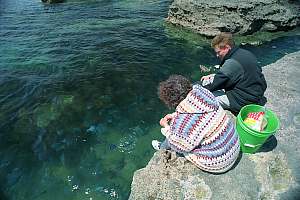 |
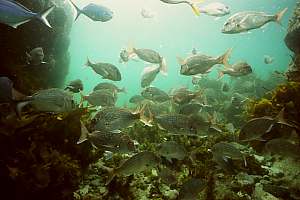 |
It is not easy to play with the fishes, because it does not consist of swimming up to them, wanting to touch and stroke them, which most people do. The fish see this unprepared approach as a frontal attack, from which they shy and flee away. By behaving like this, people have shied a number of fascinating species away, like stingrays and leatherjackets. Approaching fish for playing, requires us to behave in a much more careful and patient way. We will discuss this aspect in another Indepth chapter.
In all, it became clear that feeding the fish, however fascinating,
brought with it conflict in various ways. A solution had to be found.
The single-handed decision by DoC has been unforgivable because no consultation took place with the local community, who knows the sea best and also the value and damage of fish feeding. Immediately the number of visitors to the reserve (not counting schools) dropped to half of its original value. Local businesses suffered losses. Seafriends for example, made losses amounting to $30,000 for each successive year. The chance of educating people about the value of marine reserves almost evaporated, since also the fishes disappeared. But worse was still to come.
Because people were stopped on the beach when seen with fish food, they
resorted to a different method. The sea had plenty of food in the form
of sea urchins. With a knife or stone these could be broken open. It was
simple and effective. The fish loved the fresh nutricious food. But taking
life from a reserve is wrong, and not surprisingly, an offence. By taking
urchins, the rocks are no longer grazed, allowing seaweeds to occupy the
once barren spaces. The environment changed. Yet worse was still to come.
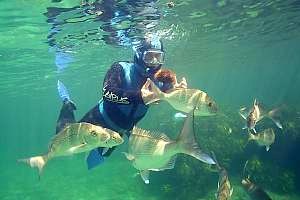 |
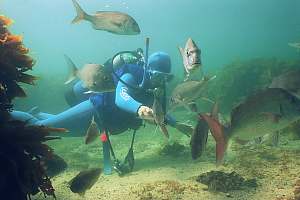 |
What people do not realise, is that the Goat Island marine reserve experiences
a rapid decline in water quality, and with it an equally rapid decline
in numbers of species and individuals. Since the late 1980s, erosion from
adjacent land has been accelerating, resulting in muddy waters after each
heavy rain storm, followed by dense plankton blooms. Because these happen
mainly in winter and spring, when few people visit the beach, this has
largely been left unnoticed. The mud suffocates water-breathing animals
like sponges and fishes. But the fishes can swim away to clearer water,
which is what they do. When the water clears up, they return to the beach.
But they do so only when food is offered as incentive. In other words,
there are two opposing forces at work: the mud repelling the fish, while
food is attracting them. Leave the food out, and the fish will stay away,
which is exactly what happened.
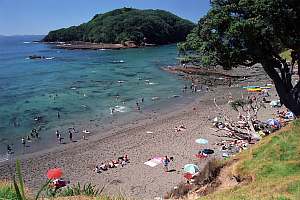 |
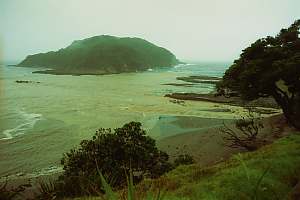 |
First of all, we must believe that people who come to the reserve are of a good nature, and willing to help. They just don't know that there are problems, and they don't know what to do. So, the problem should have been presented, as it is here, on a publication panel, complete with options. People can then choose according to their particular situation.
Since the quantity fed was the main problem, people could be encouraged not to buy fish food. People's favourite choice of food consists of frozen peas, because these dispatch in small parcels. Unfortunately, frozen peas are sold in large bags only. Although not their natural food, zooplankton-feeding blue maomao and trevally took to them, as did plant-feeding parore. Snapper and blue cod were more interested in bread and dog-rolls, which for them were the most favoured because of their high protein content.
|
Paul Charman, Rodney times, 27 Dec 2001 DOC's ban followed dozens of reports from divers and swimmers suffering nips on unguarded flesh. Foolhardy divers who held food in their teeth for the fish to take, occasionally reported torn lips. And a snorkeller feeding frozen peas to blue cod was terrified when an excited snapper attacked his ear. In addition to the safety angle, DOC claimed the feeding was polluting the water with food waste, making the fish vomit and changing their natural behaviour. "But the feeding practice brought throngs of fish to the beach," says veteran Goat Island diver, Floor Anthoni. Mr Anthoni claims fish deserted in droves when feeding stopped, while still more fish have been driven away by silt intrusion from the creek running through the reserve. "DOC made its decision without consulting local tourist operators," he complains. "The department should allow some controlled feeding to bring the fish in again, and allow people to enjoy them," he says. "It's perfectly natural for humans to feed animals and when you think about it, it's the only nice thing we do for them here. Fish don't gain anything from the money DOC spends on roading and amenities." But natural history photo-journalists Tony Enderby claims the feeding got well beyond a joke. "Some days people arrived with armfuls of bread, huge bags of frozen peas and large dog rolls. At times it left an oily scum on the water. And some fish choked on the plastic bags or dog roll wrappers." The swarms of blue cod have not left entirely, he believes, but moved to the outer part of the reserve when feeding stopped. Even without the lure of food, Mr Enderby admits tame blue cod and other species will sometimes gently nibble ungloved fingers, 'just to check you out'. Bob Dickson, Area Manager Department of Conservation Rodney Times 15 January 2002 The fundamental purpose of any marine reserve is to maintain the marine environment in its natural state (false). Activities such as feeding of fish by the public, particularly to the excessive and bizarre extent exhibited at Goat Island until recently, interfere with the natural food balance and behaviour of many fish species. These activities have never been lawful at Goat Island and are in fact offences under the Marine Reserves Act (false). It is therefore not correct to allege Department of Conservation has introduced a ban on such practices. What has occurred, as visitor numbers increased, is an increase in warnings by DOC rangers and in signage requesting the public not to feed the fish. DOC also received advice from the nearby Leigh Marine Laboratory, whose research highlighted a growing problem with species' unnatural behaviour patterns associated with fish feeding practices by the public. While DOC recognises the expectations of visitors to this unique area, it has to be made clear that where there is conflict between visitor behaviour and preserving the conservation values of the marine reserve, it is DOC's duty, as I'm sure the public of New Zealand would insist, to ensure the welfare of the reserve is paramount. There is no question that fish feeding did encourage a large number of fish, particularly blue maomao into shallow water at the beach. Most of these fish have now gone back to their natural habitat of mid-to-deeper water within the reserve. Here they enjoy an abundant and natural diet of plankton, copepods and algae, instead of bread, frozen peas and dog rolls. The reported complaint that 'DOC made its decision without consulting local tourist operators', apart being wrong insofar as no decision was made, displays ignorance of the fact that the management plan for Goat Island was widely advertised in draft form (false). Many submissions were received from the community, including dive operators. The final plan, adopted in 1998 after a public meeting, addressed the issue of fish feeding raised through this consultation process. (DOC has a bad reputation re consultation, as documented extensively on this website) DOC appreciates the concern shown by the Rodney Times by giving prominence to this matter and hope the above assists in explaining the situation. |
| Related issues on this web site:
Introduction to marine reserves: an in-depth introduction of marine reserves and why coastal marine reserves fail in NZ. The war for marine reserves: The NZ government wants more, by hook or by crook. But people become aware. The Goat Island marine reserve: history, geography, ecology, dive sites. A virtual visit with many photos. The Poor Knights marine reserve: New Zealand's second marine reserve and best dive spot. A virtual visit. The Kermadec Islands marine reserve: an isolated group of small volcanic islands in a wide open ocean. A virtual visit. Niue Island: a cool-tropical paradise in a gin-clear ocean. A virtual visit. |
-- Seafriends home -- indepth
index -- site map -- Revised: 20060808,20071012,